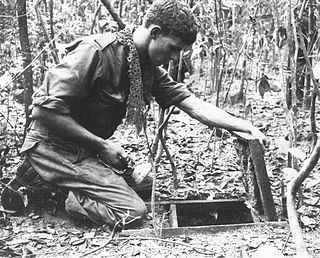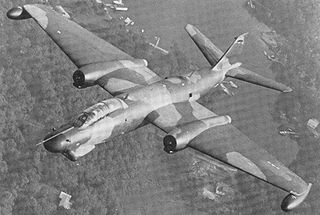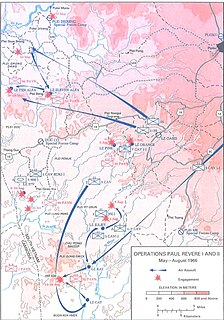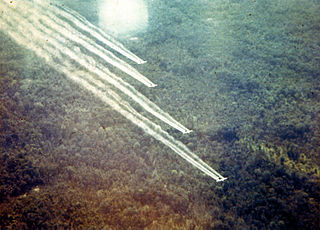 W
WDuring Operation Arc Light from 1965 to 1973, the United States deployed B-52F Stratofortresses from bases in the US to Guam to provide Battlefield air interdiction or BAI, including strikes at enemy bases, supply routes and behind the lines troop concentrations, as well as occasionally providing close air support (CAS) directly to ground combat operations in Vietnam. The conventional bombing campaign was supported by ground-control-radar detachments of the 1st Combat Evaluation Group (1CEVG) in Operation Combat Skyspot. Arc Light operations usually targeted enemy base camps, troops concentrations, and supply lines.
 W
WThe Bình Hòa Massacre was a massacre purportedly conducted by South Korean forces between December 3 and December 6, 1966, of 430 unarmed citizens in Bình Hòa village, Quảng Ngãi Province in South Vietnam. In 2000, however, it was reported that a monument within the village, gave the dates of the massacre as October 22, 24, and 26, 1966 and said that 403 people were killed by the South Koreans.
 W
WThe Bình Tai Massacre was a massacre allegedly perpetrated by South Korean Forces on 9 October 1966 of 29-168 citizens in Binh Tai village of Bình Định Province in South Vietnam.
 W
WOperation Crazy Horse, named after Lakota warrior Crazy Horse, was a search and destroy mission during the Vietnam War conducted by military forces of the United States, South Vietnam, and the Republic of South Korea in two valleys in Bình Định Province of South Vietnam.
 W
WOperation Crimp, also known as the Battle of the Ho Bo Woods, was a joint US-Australian military operation during the Vietnam War, which took place 20 kilometres (12 mi) north of Cu Chi in Binh Duong Province, South Vietnam. The operation targeted a key Viet Cong headquarters that was believed to be concealed underground, and involved two brigades under the command of the US 1st Infantry Division, including the 1st Battalion, Royal Australian Regiment which was attached to the US 173rd Airborne Brigade. Heavy fighting resulted in significant casualties on both sides, but the combined American and Australian force was able to uncover an extensive tunnel network covering more than 200 kilometres (120 mi).
 W
WOperation Harrison was an operation conducted by the 1st Brigade, 101st Airborne Division in Phú Yên Province, lasting from 26 February to 25 March 1966.
 W
WOperation Hastings was an American military operation in the Vietnam War. The operation was a qualified success in that it pushed the North Vietnamese People's Army of Vietnam (PAVN) forces back across the Demilitarized Zone (DMZ). As the PAVN clearly did not feel constrained by the "demilitarized" nature of the DMZ, US military leadership ordered a steady build-up of U.S. Marines near the DMZ from 1966 to 1968.
 W
WOperation Hawthorne took place near the village of Toumorong, Kon Tum Province, South Vietnam from 2 to 21 June 1966.
 W
WThe Battle of Hill 488 was a military engagement of the Vietnam War that took place on the night of 15–16 June 1966. A small United States Marine Corps (USMC) reconnaissance platoon inflicted large casualties on regular People's Army of Vietnam (PAVN) and Viet Cong (VC) fighters before withdrawing with only a few dead.
 W
WIn the Vietnam War, after the assassinations of Ngo Dinh Diem and John F. Kennedy in late 1963 and the Gulf of Tonkin incident in 1964 and the continuing political instability in the South, the United States made a policy commitment to begin joint warfare in South Vietnam, a period of gradual escalation and Americanization, involving the commitment of large-scale combat forces from the United States and allied countries. It was no longer assumed the Republic of Vietnam could create a desirable situation without major external assistance. This phase of the war lasted until the election of Richard Nixon, and the change of U.S. policy to Vietnamization, or giving the main combat role back to the South Vietnamese military.
 W
WOperation Lam Son II was a combined United States and South Vietnamese military and public relations operation in the village of Tân Phước Khánh, Tân Uyên District, in III Corps around 40 km north of the capital Saigon staged from June 2 to June 5, 1966 during the Vietnam War. It was done in order to simultaneously win public support for the government of South Vietnam by holding a village fair and providing social services while simultaneously screening the congregated area to arrest and remove Viet Cong guerrillas operating in the area.
 W
WOperation Lincoln was an operation conducted by the 1st Cavalry Division west of Pleiku, lasting from 25 March to 8 April 1966, with the goal of locating suspected North Vietnamese and Viet Cong bases to disrupt any planned offensives during the monsoon season.
 W
WThe Battle of Long Tan took place in a rubber plantation near Long Tân, in Phước Tuy Province, South Vietnam, during the Vietnam War. The action was fought between Viet Cong (VC) and People's Army of Vietnam (PAVN) units and elements of the 1st Australian Task Force.
 W
WOperation Masher was in early 1966 the largest search and destroy mission that had been carried out in the Vietnam War up until that time. It was a combined mission of the United States Army, Army of the Republic of Vietnam (ARVN), and Republic of Korea Army (ROK) in Bình Định Province on the central coast of South Vietnam. The People's Army of Vietnam (PAVN) 3rd Division, made up of two regiments of North Vietnamese regulars and one regiment of main force Viet Cong (VC) guerrillas, controlled much of the land and many of the people of Bình Định Province, which had a total population of about 800,000. A CIA report in 1965 said that Binh Dinh was "just about lost" to the communists.
 W
WThe Battle of Minh Thanh Road took place on 9 July 1966 when a Viet Cong force attacked a 1st Infantry Division convoy triggering a prepared US ambush, in which an overwhelming response of armour, artillery and airpower reacted to an ambushed convoy. The Viet Cong, primarily armed with RPG-2, recoilless rifles and small-arms had engaged and destroyed some vehicles in a convoy but were prevented from overwhelming the convoy through a massive response of US armoured, artillery and aerial support. Much of the attacking ambush had slipped past the aerial and armoured cordon set-up.
 W
WNgô Quang Trưởng was an officer in the Army of the Republic of Vietnam (ARVN). Trưởng gained his commission in the Vietnamese National Army in 1954 and moved up the ranks over the next decade, mostly in the Airborne Brigade. In 1966, Trưởng commanded a division for the first time after he was given command of the 1st Division after helping to quell the Buddhist Uprising. He rebuilt the unit after this divisive period and used it to repel the communists and reclaimed the imperial citadel of Huế after weeks of bitter street fighting during the Tết Offensive. In 1970, Trưởng was given command of IV Corps in the Mekong Delta and improved the situation there to such an extent that he allowed some of his forces to be redeployed to other parts of the country that were finding the communist pressure difficult.
 W
WOperation Attleboro was a Vietnam War search and destroy operation initiated by the 196th Light Infantry Brigade with the objective to discover the location(s) of People's Army of Vietnam (PAVN) and Viet Cong (VC) base areas and force them to fight. The operation was named after Attleboro, Massachusetts, where the brigade had been formed. Operation Attleboro grew to be the largest series of air mobile operations to that time, involving all or elements of the 196th Brigade, 25th Infantry Division, 1st Infantry Division and a brigade of the 4th Infantry Division, as well as numerous Army of the Republic of Vietnam and Regional Forces/Popular Forces and Nùngs. In the end, the operation became a Corps operation commanded by II Field Force, Vietnam.
 W
WOperation Birmingham was a military operation of the Vietnam War in War Zone C, north of Saigon conducted by the U.S. 1st Infantry Division and the Army of the Republic of Vietnam (ARVN) 5th Division from 24 April to 17 May 1966.
 W
WOperation Market Time was the United States Navy and South Vietnam's successful effort begun in 1965 to stop the flow of troops, war material, and supplies by sea, coast, and rivers, from North Vietnam into parts of South Vietnam during the Vietnam War. Also participating in Operation Market Time were United States Coast Guard Squadron One and Squadron Three. The Coast Guard provided heavily armed 82-foot (25 m) patrol boats and large cutters that included 5" cannon used in battle and gunfire support.
 W
WOperation Shed Light was a crash development project in aerial warfare, initiated in 1966 by the United States Air Force to increase the ability to accurately strike at night or in adverse weather. During the 1960s the United States military worked hard to interdict the movement of men and materiel along the Ho Chi Minh trail. The North Vietnamese were experts in the use of weather and darkness to conceal their movement, and understanding the superiority of American air power put their skills immediately to good use. US forces seeking to impede the steady flow of supplies attempted to locate largely static targets during the day with poor results.
 W
WOperation Oregon was a US Marine Corps operation that took place on the Street Without Joy approximately 36km northwest of Huế, lasting from 19 to 23 March 1966.
 W
WOperation Paul Revere was a 3rd Brigade, 25th Infantry Division operation that took place west of Pleiku, lasting from 10 May to 1 August 1966.
 W
WOperation Paul Revere IV was a United States Army operation of the Vietnam War that took place in the Plei Trap Valley, lasting from 20 October to 30 December 1966.
 W
WOperation Prairie was a U.S. military operation in Quảng Trị Province, South Vietnam that sought to eliminate People's Army of Vietnam (PAVN) forces south of the Demilitarized Zone (DMZ). Over the course of late 1965 and early 1966 the Viet Cong (VC) and the PAVN intensified their military threat along the DMZ. The tactical goal of these incursions was to draw United States military forces away from cities and towns. Operation Hastings, a series of actions in defense of the DMZ, lasted from 15 July to 3 August 1966. It was considered a strategic success. Operation Prairie was conceived as a larger, longer mission covering the same areas along the DMZ.
 W
WOperation Ranch Hand was a U.S. military operation during the Vietnam War, lasting from 1962 until 1971. Largely inspired by the British use of 2,4,5-T and 2,4-D during the Malayan Emergency in the 1950s, it was part of the overall chemical warfare program during the war called "Operation Trail Dust". Ranch Hand involved spraying an estimated 20 million U.S. gallons (76,000 m3) of defoliants and herbicides over rural areas of South Vietnam in an attempt to deprive the Viet Cong of food and vegetation cover. Areas of Laos and Cambodia were also sprayed to a lesser extent. Nearly 20,000 sorties were flown between 1961 and 1971.
 W
WOperation Silver City was an operation conducted by the 1st Brigade, 1st Infantry Division and the 173rd Airborne Brigade in Biên Hòa Province, lasting from 7 to 23 March 1966.
 W
WOperation Steel Tiger was a covert U.S. 2nd Air Division, later Seventh Air Force and U.S. Navy Task Force 77 aerial interdiction effort targeted against the infiltration of People's Army of Vietnam (PAVN) men and material moving south from the Democratic Republic of Vietnam through southeastern Laos to support their military effort in the Republic of Vietnam during the Vietnam War.
 W
WThe Battle of Suoi Bong Trang was an engagement fought between US, Australian and New Zealand forces, and the Viet Cong and North Vietnamese Army during the Vietnam War. The battle occurred during Operation Rolling Stone, an American security operation to protect engineers building a tactically important road in the vicinity of Tan Binh, in central Binh Duong Province, 30 kilometres (19 mi) north-west of Bien Hoa airbase. During the fighting, soldiers from the US 1st Brigade, 1st Infantry Division and the 1st Battalion, Royal Australian Regiment, which had been attached for the operation, fought off a regimental-sized Viet Cong night assault. Repulsed by massed firepower from artillery and tanks, the Viet Cong suffered heavy casualties and were forced to withdraw by morning. After the attack, the Americans and Australians made no attempt to pursue the Viet Cong, focusing on securing the battlefield and evacuating their own casualties. The Viet Cong continued to harass the American sappers with occasional sniper and mortar fire, but these tactics proved ineffective, and the road was completed by 2 March.
 W
WOperation Thayer, Operation Irving and Operation Thayer II were related operations with the objective of eliminating People's Army of Vietnam (PAVN) and Viet Cong (VC) influence in Bình Định Province on the central coast of South Vietnam. The operations were carried out primarily by the United States (US) 1st Cavalry Division against PAVN and VC regiments believed to be in Bình Định. South Korean and Army of the Republic of Vietnam (ARVN) forces also took part in the operation.
 W
WOperation Tiger Hound was a covert U.S. 2nd Air Division, later Seventh Air Force and U.S. Navy Task Force 77 aerial interdiction campaign conducted in southeastern Laos from 5 December 1965 till 11 November 1968, during the Vietnam War. The purpose of the operation was to interdict the flow of People's Army of Vietnam (PAVN) supplies on the Ho Chi Minh Trail from the Democratic Republic of Vietnam, through southeastern Laos, and into the northern provinces of the Republic of Vietnam. The missions were originally controlled by the 2d Air Division until that headquarters was superseded by the Seventh Air Force on 1 April 1966.
 W
WOperation Van Buren was a harvest security operation conducted by the 1st Brigade, 101st Airborne Division in the Tuy Hòa Valley, Phú Yên Province, lasting from 15 January to 25 February 1966.
 W
WOperation Wahiawa was an operation conducted by the 25th Infantry Division in Hậu Nghĩa Province, lasting from 16 to 30 May 1966.
 W
WAt the beginning of 1966, the number of U.S. military personnel in South Vietnam totaled 184,314. South Vietnamese military forces totaled 514,000 including the army (ARVN) and the Regional Force and Popular Force militias. The North Vietnamese People's Army of Vietnam (PAVN) numbered 400,000, most still in North Vietnam. 50,000 PAVN cadre and soldiers infiltrated South Vietnam during 1965. Group 559, charged with transporting supplies down the Ho Chi Minh Trail to supply PAVN troops in both South Vietnam and Laos, numbered 24,400 personnel. The U.S. estimated the number of Viet Cong (VC) and PAVN soldiers in South Vietnam at nearly 280,000 by June 1966, including part-time guerrillas. A pause in the bombing of North Vietnam by U.S. warplanes had been announced by President Johnson on 24 December and remained in effect.
 W
WThe Battle of Xa Cam My was fought over two days from April 11–12, 1966, 10 miles (16 km) south of the village of Cam My in Phuoc Tuy Province, during the Vietnam War. Originally planned as a U.S. search and destroy mission intended to lure out the "crack" Viet Cong (VC) D800 Battalion, Charlie Company, 2nd Battalion, 16th Infantry Regiment soon found itself fighting for survival in the rubber plantations of Cam My village, approximately 42 miles (68 km) east of Saigon. During this battle 134 men of Charlie Company, 2/16th Infantry were ambushed by the VC and 80 percent became casualties.